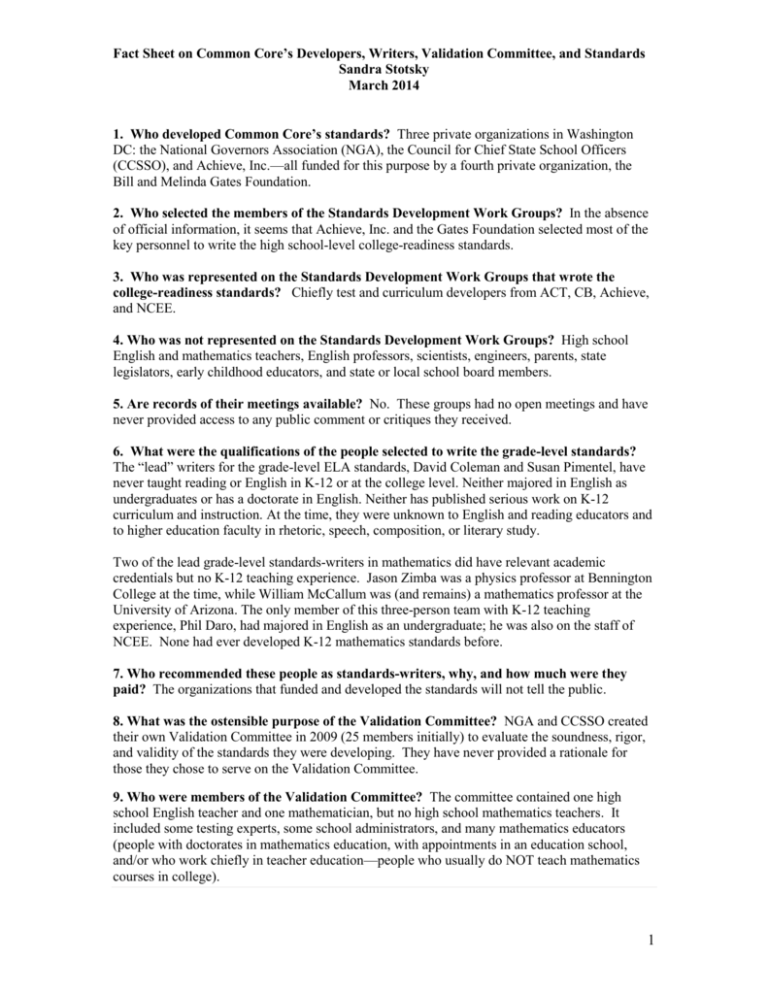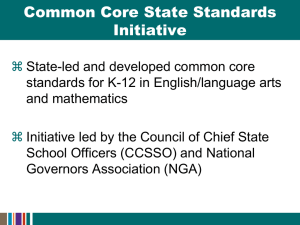Common Core's English Language Arts Standards: Problems and
advertisement

Fact Sheet on Common Core’s Developers, Writers, Validation Committee, and Standards Sandra Stotsky March 2014 1. Who developed Common Core’s standards? Three private organizations in Washington DC: the National Governors Association (NGA), the Council for Chief State School Officers (CCSSO), and Achieve, Inc.—all funded for this purpose by a fourth private organization, the Bill and Melinda Gates Foundation. 2. Who selected the members of the Standards Development Work Groups? In the absence of official information, it seems that Achieve, Inc. and the Gates Foundation selected most of the key personnel to write the high school-level college-readiness standards. 3. Who was represented on the Standards Development Work Groups that wrote the college-readiness standards? Chiefly test and curriculum developers from ACT, CB, Achieve, and NCEE. 4. Who was not represented on the Standards Development Work Groups? High school English and mathematics teachers, English professors, scientists, engineers, parents, state legislators, early childhood educators, and state or local school board members. 5. Are records of their meetings available? No. These groups had no open meetings and have never provided access to any public comment or critiques they received. 6. What were the qualifications of the people selected to write the grade-level standards? The “lead” writers for the grade-level ELA standards, David Coleman and Susan Pimentel, have never taught reading or English in K-12 or at the college level. Neither majored in English as undergraduates or has a doctorate in English. Neither has published serious work on K-12 curriculum and instruction. At the time, they were unknown to English and reading educators and to higher education faculty in rhetoric, speech, composition, or literary study. Two of the lead grade-level standards-writers in mathematics did have relevant academic credentials but no K-12 teaching experience. Jason Zimba was a physics professor at Bennington College at the time, while William McCallum was (and remains) a mathematics professor at the University of Arizona. The only member of this three-person team with K-12 teaching experience, Phil Daro, had majored in English as an undergraduate; he was also on the staff of NCEE. None had ever developed K-12 mathematics standards before. 7. Who recommended these people as standards-writers, why, and how much were they paid? The organizations that funded and developed the standards will not tell the public. 8. What was the ostensible purpose of the Validation Committee? NGA and CCSSO created their own Validation Committee in 2009 (25 members initially) to evaluate the soundness, rigor, and validity of the standards they were developing. They have never provided a rationale for those they chose to serve on the Validation Committee. 9. Who were members of the Validation Committee? The committee contained one high school English teacher and one mathematician, but no high school mathematics teachers. It included some testing experts, some school administrators, and many mathematics educators (people with doctorates in mathematics education, with appointments in an education school, and/or who work chiefly in teacher education—people who usually do NOT teach mathematics courses in college). 1 Fact Sheet on Common Core’s Developers, Writers, Validation Committee, and Standards Sandra Stotsky March 2014 10. What was the real purpose of the Validation Committee? To have members sign a letter by the end of May 2010 asserting that the not-yet-finalized standards were (1) reflective of the core knowledge and skills in ELA and mathematics that students need in order to be college- and career-ready; (2) appropriate in terms of their level of specificity and clarity; (3) comparable to the expectations of other leading nations; and (4) informed by available research or evidence. 11. What are the chief deficiencies of Common Core’s standards? * The standards are not internationally benchmarked. * The standards are not research-based. * The standards are not rigorous. They omit high school mathematics standards leading to STEM careers, stress writing over reading, divide all reading instructional texts into “information” and “literature,” use an experimental approach to teaching Euclidean geometry, defer the completion of Algebra I to grade 9 or 10, are developmentally inappropriate in the primary grades, and use the high school English class for informational reading instruction. 12. What reports comparing Common Core’s standards with Massachusetts’ standards were used to justify Massachusetts’ adoption of Common Core’s standards? 1. A report by Achieve, Inc. that was funded by the Gates Foundation. 2. A report by the Thomas B. Fordham Institute that was funded by the Gates Foundation. 3. A report by WestEd that was commissioned by the Massachusetts Business Alliance in Education and funded by the Gates Foundation via the James B. Hunt Institute in North Carolina. 4. Reports by Massachusetts Department of Education-appointed reviewers from local schools and colleges. 13. What conclusions did these reports draw? That there was no significant difference between Common Core’s standards and the Massachusetts mathematics and ELA standards. 14. What are the major flaws in Common Core’s English language arts standards? 1. Most of Common Core’s college-readiness and grade-level reading standards are contentfree skills. 2. Common Core’s ELA standards stress writing more than reading at every grade level. 3. Common Core’s writing standards are developmentally inappropriate at many grade levels and lack coordination with its reading standards. 4. Common Core expects English teachers to spend at least half of their reading instructional time at every grade level on informational texts. 5. Common Core reduces opportunities for students to develop critical thinking. 6. Common Core’s standards are not “fewer, clearer, and deeper;” they often bundle several objectives into one statement called a standard. References Mark Bauerlein and Sandra Stotsky. (September 2012). How Common Core's ELA standards place college readiness at risk. http://pioneerinstitute.org/download/how-common-cores-ela-standardsplace-college-readiness-at-risk/ R. James Milgram and Sandra Stotsky (September 2013). Lowering the Bar: How Common Core Math Fails to Prepare High School Students for STEM . http://pioneerinstitute.org/news/lowering-the-barhow-common-core-math-fails-to-prepare-students-for-stem/ 2






